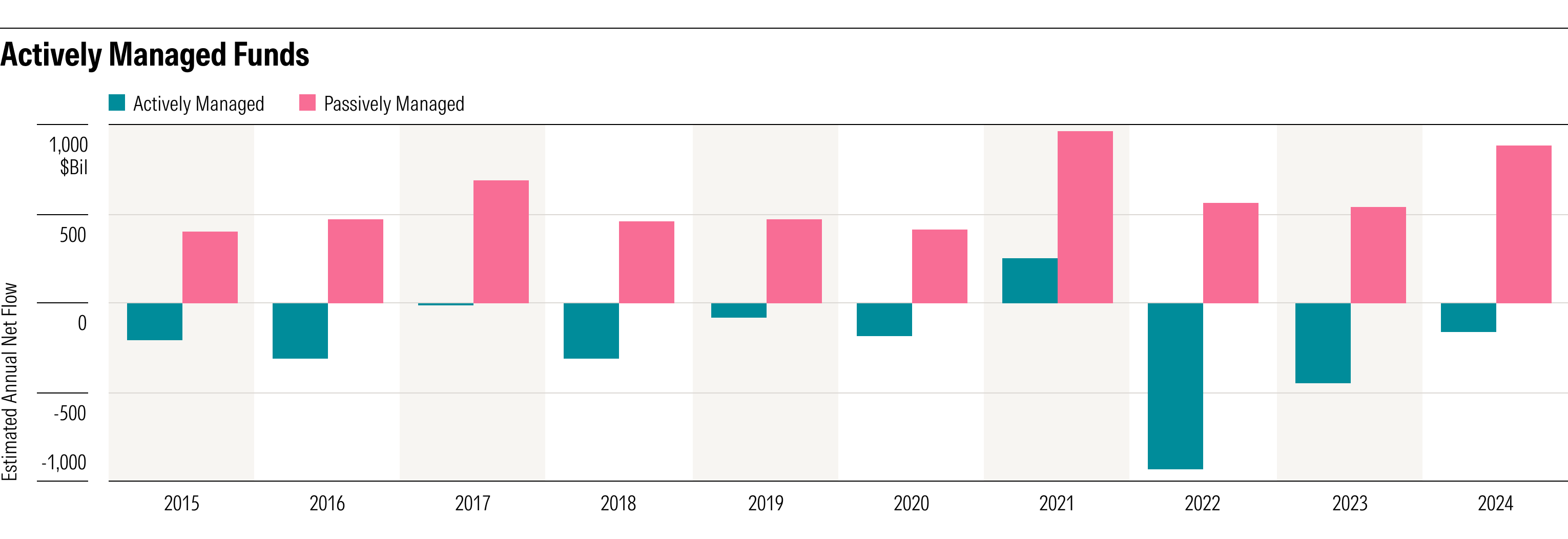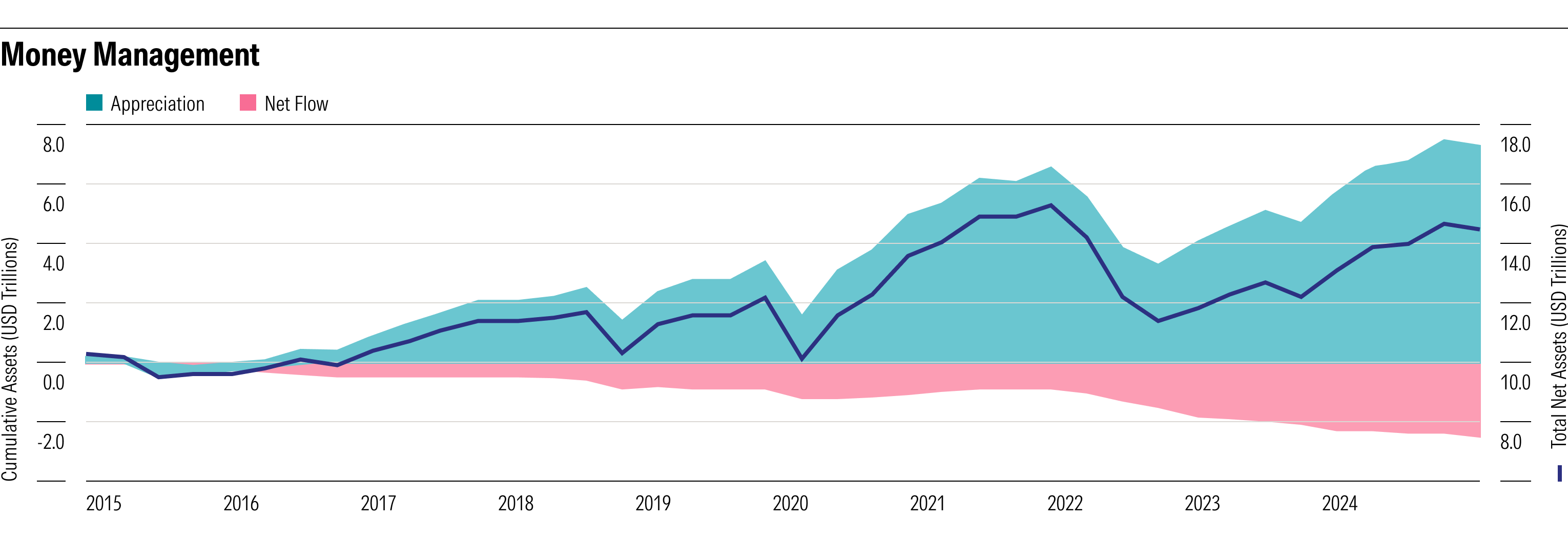5 min read
The Value of a Niche in Active Management

Key Takeaways
Passive investing dominates broad markets, but attractive opportunities for active investing exist.
Active exchange-traded funds (ETFs) and semi-transparent ETFs are allowing asset management firms to grow their best strategies.
Shifting investor priorities may encourage asset managers to move beyond traditional fund structures and turn to vehicles that balance customization with scale.
Morningstar’s advanced technology and data-driven insights can help enhance active management strategies from ideation to distribution.
On this page
On this page
On this page
On this page
Amid a constantly changing environment, investment teams must evolve to stay competitive. For those at asset management firms, this growth includes truly understanding how to find attractive opportunities for active investing. The debate between active and passive strategies isn’t just about long-term averages—it’s about identifying where market structure, liquidity, and investor behavior create openings for skilled active managers to add value.
While passive investing may widely dominate markets, active investing can still outperform its counterpart in certain areas. As 2025 unfolds, active strategies are poised to stand out where inefficiencies persist or are deepening due to macro shifts, regulatory changes, and evolving investor preferences. By finding the right niche, it can be easier for active managers to boost returns and deliver value.
Here’s a closer look at the investing landscape and top areas to consider.
The Landscape: Passive Dominance in Traditional Markets
Outflows have continued to ravage actively managed funds in the US. In fact, our latest report finds that roughly 60% of firms—with at least 75% of their assets in actively managed funds—suffered outflows over the trailing five-year period through December 2024.

Actively managed funds are losing share to passive in the US.
Part of this case is likely attributable to the long-held belief that stock market efficiency in broadly covered areas, like large-cap equities, can make it challenging for active managers to consistently outperform benchmarks. Our Morningstar research may support this theory—over the decade through 2024, passive large-growth funds beat their active peers by 2.3 percentage points annualized on an asset-weighted basis, reaching the widest performance margin across all Morningstar Categories.
Yet not all news is bad news: While cost-conscious investors and fiduciary pressures have driven the shift toward passive products, actively managed funds have performed well with the help of money management. The reason being is that costs are relatively fixed, but revenues grow and decline with markets—and markets tend to go up over time, leading to tremendous profit growth. Despite suffering over $2 trillion in investor outflows over the trailing 10 years through December 2024, for example, actively managed funds’ assets appreciated by more than $7 trillion.

Actively managed funds’ assets appreciated by more than $7 trillion through 2024.
What can active managers do? By leveraging new vehicle structures and strategic distribution, active managers can gain significant advantages that allow them to better navigate the evolving landscape.
Advanced analytics will also play a key role in managing risk and maximizing alpha generation moving forward. The ability to adapt to technological advancements can differentiate successful active managers from those struggling to compete. Having partners who embed AI throughout their ecosystem may help create efficiency that leads to better decision making, incremental savings, and operational costs that can be passed onto investors.
Active ETFs: The New Battleground for Flows
Flows are now shifting away from traditional mutual funds. As a result, the ability to deliver actively managed strategies in an exchange-traded fund (ETF) wrapper no longer appears optional. Today’s investors demand lower fees, tax efficiency, and intraday liquidity—advantages ETFs naturally provide.
But the real edge for active managers is the rise of semi-transparent ETF structures— solutions that allow firms to scale their best strategies without revealing their special sauce. Those who embrace the ETF shift will likely capture the next wave of asset flows while those who hesitate may risk watching their AUM migrate to competitors who already leverage these vehicles.
What can active managers do? Now more than ever, active managers must educate themselves on the opportunities and risks of active ETFs. Incorporating the right active ETFs into their offerings can lead to active managers standing out and delivering better strategies.
Market Shifts: A Chance to Adapt and Stand Out
Active managers who adapt to emerging inefficiencies can gain an edge—particularly in asset classes where market dislocations, complex pricing mechanisms, and information asymmetries create pricing gaps.
- Emerging markets: While emerging markets can be a fertile space for active managers, diversified emerging market funds saw their success rates drop from 58% to 22% within one year. To find success in emerging markets, active managers must manage risk efficiently and utilize their research capabilities to find attractive opportunities.
- Private markets and alternatives: The convergence of public and private investments have asset managers exploring opportunities in private equity and private credit—alternative investments where liquidity constraints make traditional passive replication particularly difficult. The increasing tokenization of private assets could also shift how active managers provide access and enhance liquidity solutions.
- Real estate: Active real estate strategies saw a 66% success rate in 2024, up six percentage points year over year. Yet, the true opportunity may lie in active managers’ ability to navigate interest rate shifts, debt refinancing risks, and sector-specific dislocations.
What can active managers do? The volume and variety of investable products/securities have skyrocketed—outpacing the industry’s capacity to effectively assess each new vehicle, asset class, and security. Although opportunities exist, they demand equally rigorous data oversight, especially as private markets expand and public offerings converge. By avoiding poor or fragmented data sets and adding tools that allow for deeper analysis of public and private assets in one place, active managers can make more strategic decisions.
Investment Vehicles: An Opportunity for Customization and Scale
Investors no longer see active and passive as a binary choice—they expect flexibility, tax efficiency, personalization, and risk management in every allocation decision. As demand shifts, asset managers must move beyond traditional fund structures and turn to vehicles that balance customization with scale.
Successful firms won’t just adopt these strategies but will differentiate their execution in ways that drive sustained AUM growth.
Here are top investment vehicles to consider:
Separately managed accounts (SMAs)
Given passive investing continues to pressure fees and performance, active managers must rethink how they deliver value. The value of separately managed accounts (SMAs) isn’t just in tax efficiency—it’s in how asset managers integrate real-time analytics, dynamic factor tilts, and portfolio construction to enhance after-tax alpha. SMAs offer much-needed precision which enables tax-loss harvesting, direct security selection, and tailored factor tilts that enhance after-tax alpha.
Customizable model portfolios
Model portfolios aren’t just about efficiency—they’re becoming a primary distribution strategy. Asset managers who create models tailored to RIA platforms and digital wealth channels are gaining distribution advantages while maintaining investment discretion. Model portfolios unlock scalability and efficiency, allowing for tactical asset allocation, smart beta overlays, and seamless portfolio adjustments in response to market conditions.
These vehicles not only help investment teams compete, but they enable a more flexible, cost-effective approach to portfolio construction—bridging the gap between customization and scale. Firms that master these tools and adjust to the evolution of model portfolios will be well-positioned to capture flows and reinforce their value proposition. Most importantly, they can drive better outcomes for investors.
Direct indexing: Active management’s stealth play
The shift in direct indexing goes further than expansion into new asset classes beyond the large cap space they play today. Instead, the focus is on how asset managers are using this investment vehicle to blend active and passive advantages.
As direct indexing blurs the line between passive and active management, smart beta and thematic overlays (ESG and Factor exposures) are advancing direct index products into highly customizable solutions.
What can active managers do? Partnering with providers that offer data and analytics encompassing extensive risk modeling, style box attribution, rating capabilities, and research across investment vehicles can help investment teams maximize their strategic advantage and craft new portfolios to expand their product lineups.
Fixed-Income Investments: 2024’s Best-Performing Active Asset Class
Active bond funds have been outperforming their passive counterparts. Specifically, active intermediate core bond managers are leading the pack with a 79% success rate, up 18 percentage points from 2023. This may not be surprising: Active bond managers can have an edge in today’s fixed-income markets with the support of fundamental research, issuer-level insights, and sector-specific analysis.
But fundamental research isn’t the only difference. With credit spreads widening and economic uncertainty creating dispersion across issuers, access to independent credit ratings and forward-looking analysis has become essential.
What can active managers do? By leveraging our credit analytics tools to assess risk-adjusted opportunities—whether in corporate bonds, municipals, or structured credit—active managers can navigate market inefficiencies with greater precision, positioning themselves to sustain their performance advantage.
Checklist: How Asset Managers Can Stay Ahead
Investors are no longer choosing active versus passive based on ideology—they’re looking for the best possible outcome in regard to their risk tolerance and portfolio. The firms that win in 2025 should not lean on past performance, but they’ll define where and how their active strategies exploit market inefficiencies.
To stand out in a crowded market, asset managers must demonstrate key traits such as:
- Data-driven product development: Utilize solutions that can break down silos across sales, marketing, product, and portfolio management to bring about an integrated narrative.
- Research-backed investment decisions: Access to objective research and ratings that extend across public, private, and sustainable asset classes to assist in making informed investment choices.
- Enhanced distribution and customization: Seek ecosystems that enable scalable personalization in SMAs, direct indexing, and model portfolios.
Asset managers must also ask themselves important questions, including:
- Are you identifying the right inefficiencies? Investigate further than broad asset class designations. Consider new investment vehicles —look internally and pinpoint the specific edge in extracting value where passive falls short.
- Do you have complete confidence in your data sources? Partner with providers who not only have robust, timely, and accurate data, but objective research that backs itup. These providers should be innovating when it comes to alternative data, AI-driven analytics, and localized intelligence.
- Are you positioning active as a strategic tool? Investors increasingly see active management as a complement to passive allocations rather than an all-or-nothing decision. Make the case for how active fits into broader portfolio construction by clearly communicating with clients.
Gain a Competitive Edge
Active management still thrives—but success depends on more than actively making decisions. The best investment teams will offer a clear, data-backed case for why they win where passive falls short.
Deliver quality offerings with Morningstar Direct. Our comprehensive platform helps asset managers build assets and manage portfolios by supporting market research, product creation, positioning, marketing, and distribution strategies.


